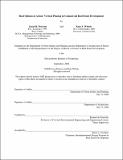Real options in action : vertical phasing in commercial real estate development
Author(s)
Pearson, Jason R; Wittels, Kate S
DownloadFull printable version (2.592Mb)
Alternative title
Vertical phasing in commercial real estate development
Other Contributors
Massachusetts Institute of Technology. Center for Real Estate.
Advisor
Richard de Neufville.
Terms of use
Metadata
Show full item recordAbstract
Real estate development is inherently a risky endeavor. Developers encounter varied risks during the different phases of a development project, from permitting to construction and through lease-up and stabilized operations. Flexibility allows a developer to mitigate some of these risks by capitalizing on potential upsides, and reducing the effects from possible downsides. Flexibility, and phasing specifically, enables a developer to manage risk more effectively by allowing a building to grow as market conditions warrant. This thesis investigates the determinants and implementation of vertical phasing, and suggests areas of applicability for vertically phased development. By "vertical phasing", we mean when a building is originally constructed to a certain height, but includes the intentional capacity for it to expand vertically in the future. Vertical phasing is an example of a real option "in" real estate development. A real option embodies a right, but not an obligation to pursue a future course of action. Flexibility, or real options, in real estate is important because it can add value to a project. The significant expansion of tall buildings is a recent phenomenon, though vertical phasing itself is not new. Expanding a one story building to two stories, for example, is a common example of vertical phasing. This thesis examines the decision and development process of major buildings that are constructed with the intentional ability to be expanded vertically in the future without disrupting the occupation and operations of the original building. While the intention is that the vertical expansion will take place at some appropriate time in the future, if such an opportunity never arises, the original building can exist by itself as a complete, fully functioning structure. (cont.) Drawing from a study of four buildings in the United States and Canada, this thesis examines the context in which vertical phasing of buildings is employed. It first considers the various drivers that lead to vertical phasing. It then discusses the specific issues and challenges with respect to vertical phasing. This thesis argues that while vertical phasing of buildings is rare and complex, it is a viable method of development that has significant potential in enhancing the value of buildings. Specifically, vertical phasing is relevant to corporate real estate development, in which less quantifiable value drivers of a building are tangible and important. By evaluating the drivers and implementation of vertical phasing, this thesis shows that vertical phasing of buildings may be easier than commonly believed, and may be used effectively in corporate real estate development and possibly other sectors of the real estate industry.
Description
Thesis (S.M. in Real Estate Development)--Massachusetts Institute of Technology, Dept. of Urban Studies and Planning, Center for Real Estate, 2008 [first author]; and, (S.M. in Real Estate Development)--Massachusetts Institute of Technology, Dept. of Architecture, Center for Real Estate, 2008 [second author]. Includes bibliographical references.
Date issued
2008Department
Massachusetts Institute of Technology. Center for Real Estate; Massachusetts Institute of Technology. Department of Architecture; Massachusetts Institute of Technology. Department of Urban Studies and PlanningPublisher
Massachusetts Institute of Technology
Keywords
Urban Studies and Planning., Architecture., Center for Real Estate.